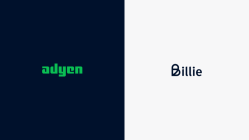
Nexo-Standards
05 SEPTEMBER 2018
ADYEN REJUVENATES IN-STORE PAYMENT INTEGRATION WITH AN API POS SOLUTION POWERED BY NEXO STANDARDS
Introduction
Adyen is the payments platform of choice for many of the world’s leading companies, providing a modern end-to-end infrastructure that connects directly to Visa, Mastercard, and consumers’ globally preferred payment methods. Adyen delivers frictionless payments across in-store, mobile and ecommerce channels. Its key customers include L’Oreal, Superdry, Facebook, Uber, Netflix, Spotify, Tory Burch, Casper and Bonobos.
Today, POS payments still represent the largest global volume, yet the majority of systems remain awkward and inefficient. This case study explores how the adoption of the nexo Retailer Protocol enabled Adyen to deliver a unique way of combining sales and payment systems simply and cost-effectively, with a standardised and centralised solution that delivers real business benefits.
The challenges
Merchants have long grappled with the cumbersome process of connecting payments and sales solutions in a traditional in-store point of sale (POS) set up.
This is because the two functions (sales and payments) are managed separately, locally, and usually in different programming languages. Merchants are then forced to rely on software ‘libraries’ to integrate the POS registers, terminals and payments systems. Being tied to these complex and extensive libraries not only incurs high initial set-up costs, but also adds complexities to service upgrades and prohibits quick roll-outs of new payment innovations.
To account for programming language compatibility issues with this model, localised updates need to be done manually, meaning management of terminal fleets is difficult and slow. Business risks apply here too, as forced updates and PCI exposure can leave sales staff inconvenienced if these updates occur during trading hours and create resourcing issues for back office staff when updates are required across all store locations.
Adyen saw the opportunity to redefine in-store payments integration and help large international enterprises and leading domestic merchant leaders to overcome these challenges. Adyen looked to nexo’s protocols as a cornerstone for developing a powerful, innovative and modern solution fit for some of the world’s biggest leading retailers.
Why nexo?
Keen to offer merchants a modern way of connecting in-store terminal hardware to its single payment platform, Adyen assessed the nexo Retailer Protocol. This protocol defines a set of interfaces between a card payment application and a retail point of sale system, and Adyen quickly found it was able to accommodate merchants’ needs in a variety of ways. Here’s why nexo works for them:
The cloud’s the limit
The nexo Retailer Protocol enables Adyen to centralise its solution with cloud or local-based API options that transform the current resource-intensive, one-to-one library management into a simple, agnostic service model that updates in real-time.
As the local and cloud integrations use standard internet access, there is also no need for complex client configurations. Merchants simply ‘plug and play’ their terminals to install them and benefit from the latest services.
This interoperable and centralised integration process alleviates the business risks for both the payment processor and its merchant customers. For Adyen, it also means they enhance their payment offering at the point of sale, while delivering consistent integration between POS terminals, cash register systems and their payment platform.
Simplify upgrades globally
By standardising the exchange of payment acceptance data, Adyen is able to realise huge operational efficiencies for merchants. This includes mitigating a number of risks such as forced updates if old versions aren’t actively managed and having multiple devices on different versions. Both aspects also drastically slow the delivery of new services, such as shoppers preferred payment methods and makes fleet management complex. With the Terminal API using the nexo protocol, the delivery of new services and system upgrades are dramatically streamlined, removing reliance on local installs of software and updates.
nexo’s basic interaction model is request/response JSON messaging. This means that making a payment with the Terminal API is a simple request-response, and all informational events, such as notifying where the terminal is in the payment process, are communicated via JSON webhooks that are optionally implemented. This standardised JSON messaging format, rather than customised libraries, call-backs and SDKs, makes it far easier for merchants to update and roll-out new software.











